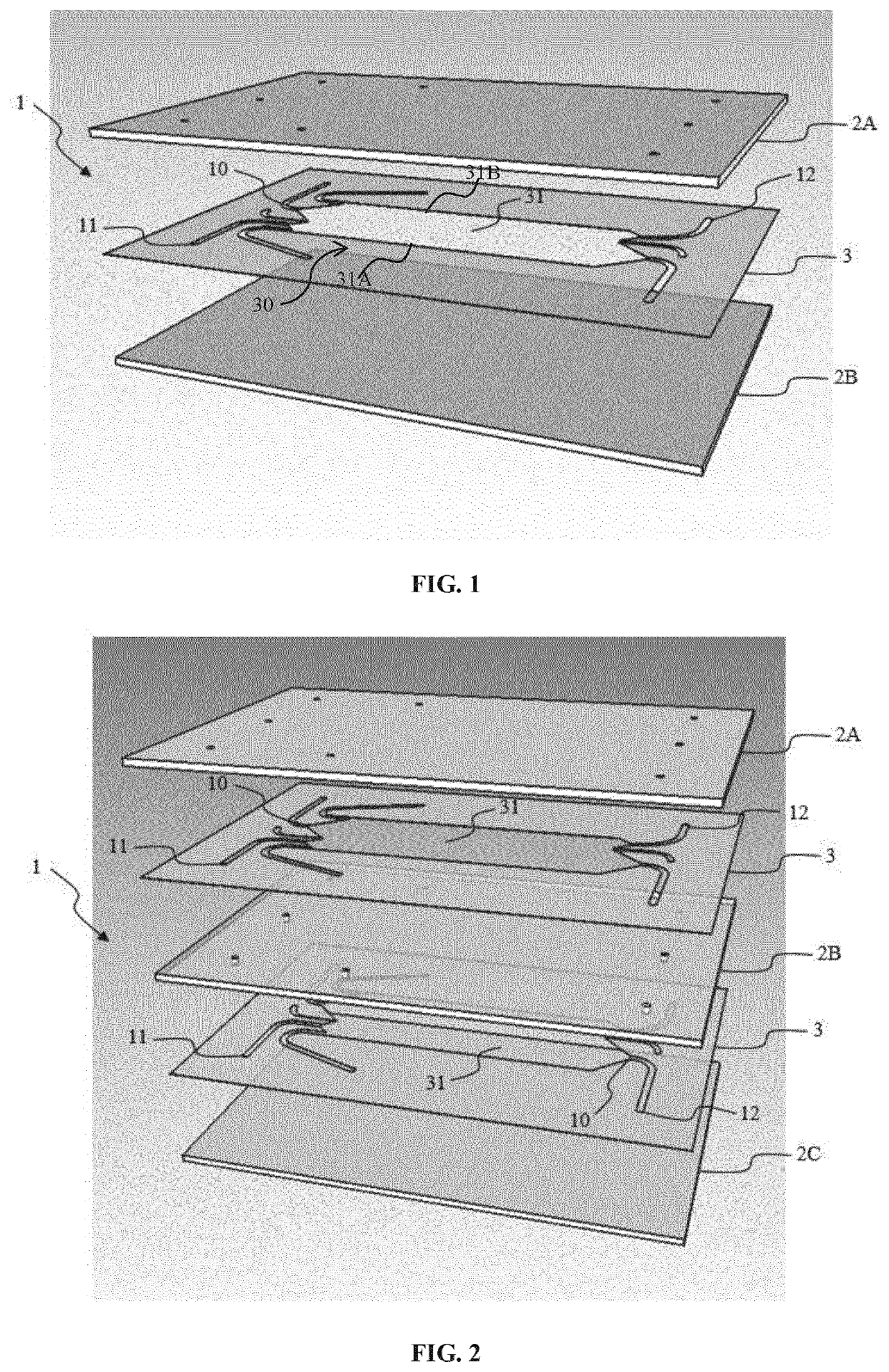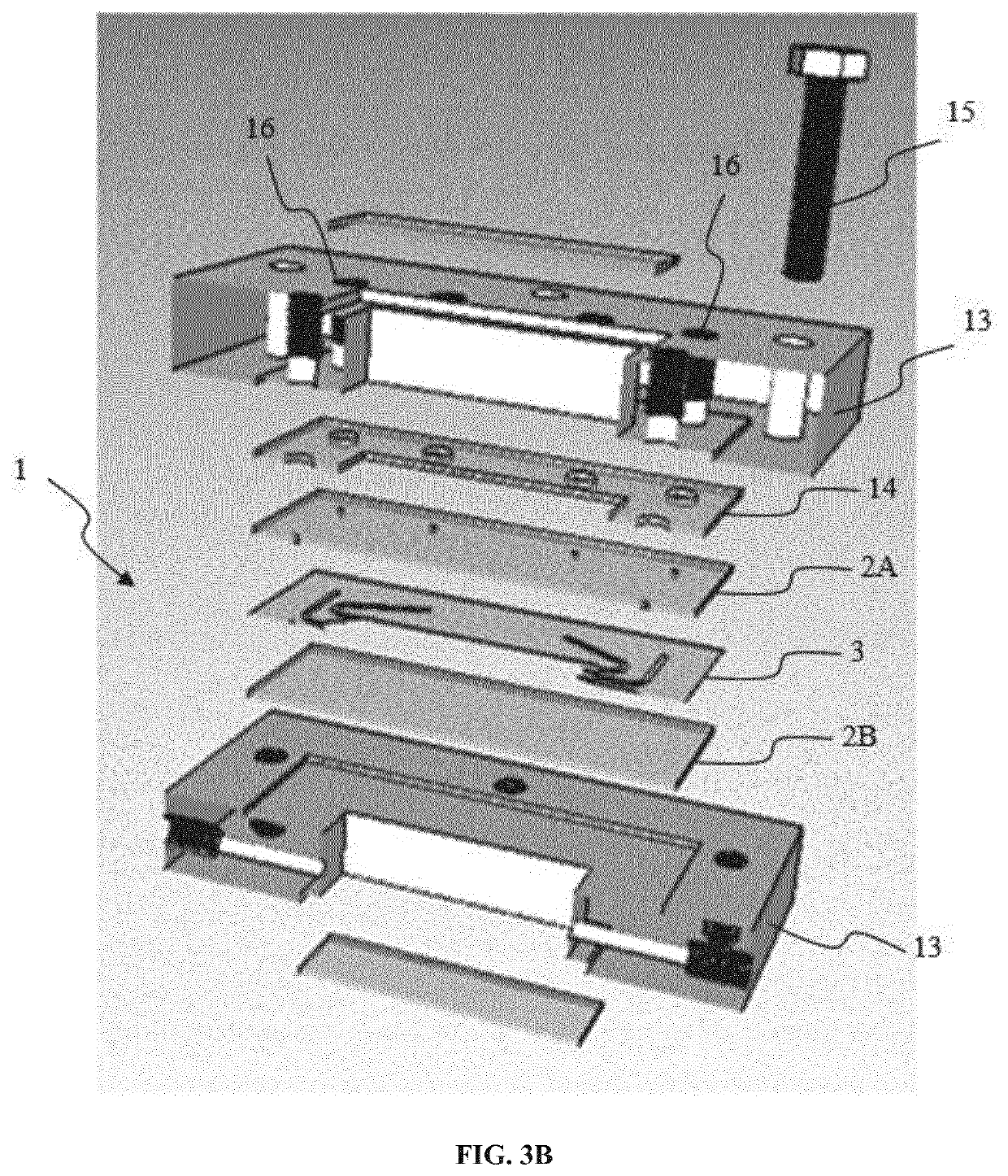Microchip for free flow electrophoresis
a microchip and electrophoresis technology, applied in the field of free flow electrophoresis, can solve the problems of unfavorable use of available devices, and limiting the performance of ffe chips, so as to achieve good microfluidic properties, high electrical stability, and easy to purchase
- Summary
- Abstract
- Description
- Claims
- Application Information
AI Technical Summary
Benefits of technology
Problems solved by technology
Method used
Image
Examples
example 1
[0176]In a first embodiment, a sample of fluorescein sodium salt (Sigma, ref 46860-25G-F) is injected, at 5 μL / min, through the inlet 11 while carrier solutions are flown in, alongside the highly conductive solutions, at 100 μL / min, to sheath and focus the sample stream.
[0177]The stream remained stable for more than an hour even when the injection flow was varied down to 0.5 μL / min or up to 25 μL / min.
[0178]In this embodiment, low conductive carrier was HEPES 10 mM, pH 7.5, HPMC 0.2% (w / v), Tween 20 0.1% (w / v).
[0179]In one embodiment, the highly conductive buffer solution was HEPES 10 mM, pH 7.5, HPMC 0.2% (w / v), Tween 20 0.1% (w / v), Methanol 40% (v / v). 0.5 M KCl and Fluorescein sodium salt used as visual marker for monitoring the flowing electrodes fluidics.
[0180]In another embodiment, the highly conductive solution used as flowing electrode is prepared with HEPES 5 mM, pH 7.5, HPMC 0.2% (w / v), Tween 20 0.1% (w / v), Methanol 40% (v / v), 0.5 M KCl, with conductivity ˜30 mS / cm. Rhodamin...
example 2
[0181]In a second embodiment, the sample is a mixture made with Rhodamine B, Rhodamine 6G and Fluorescein. It was processed into the separation chamber 31 under a 1.5 kV voltage: at pH 7.5, the said chemicals are respectively neutral, monocationic and dianionic. The sample is injected at 15 μL / min, focused by low conductive solution, i.e. carrier 5, at both sides injected evenly at 250 μL / min with residence time1.5) is achieved. Fluidics were stable, no bubbles were matched and the deflection and separation angle between the streams remained constant during the experiment, which lasted for about 5 minutes.
[0182]The low conductive and the highly conductive solutions are as described in Example 1.
example 3
[0183]In a third embodiment, the sample was a mix of fluorescein coupled to lysine at different molar ratios. The mix was processed into a chip comprising two stacked chambers (n=1) under a 500 V voltage: at pH 7.5, the said chemicals are neutral or negatively charged. The sample is injected at 11 μL / min, focused by low conductive solution at both sides injected at 175 μL / min. The molecules deflected according to expectations and a base-line resolution (Rs>1.5) is achieved for at least 3 different components. The streams were stable. At the start and for a few dozen seconds there was a gap between the patterns in the two chambers. Over time electric fields in each chamber stabilize and there was no more any gap at visual inspection. The separation was carried for 30 minutes with steady deflections and no bubbles sighted.
[0184]The low conductive and the highly conductive solutions are as described in Example 1.
PUM
 Login to View More
Login to View More Abstract
Description
Claims
Application Information
 Login to View More
Login to View More - R&D
- Intellectual Property
- Life Sciences
- Materials
- Tech Scout
- Unparalleled Data Quality
- Higher Quality Content
- 60% Fewer Hallucinations
Browse by: Latest US Patents, China's latest patents, Technical Efficacy Thesaurus, Application Domain, Technology Topic, Popular Technical Reports.
© 2025 PatSnap. All rights reserved.Legal|Privacy policy|Modern Slavery Act Transparency Statement|Sitemap|About US| Contact US: help@patsnap.com



